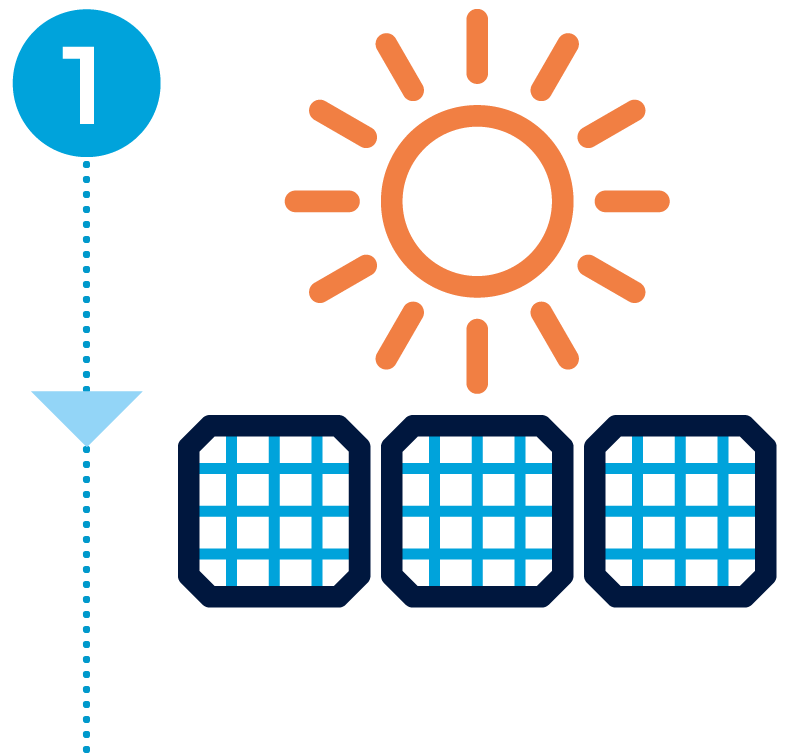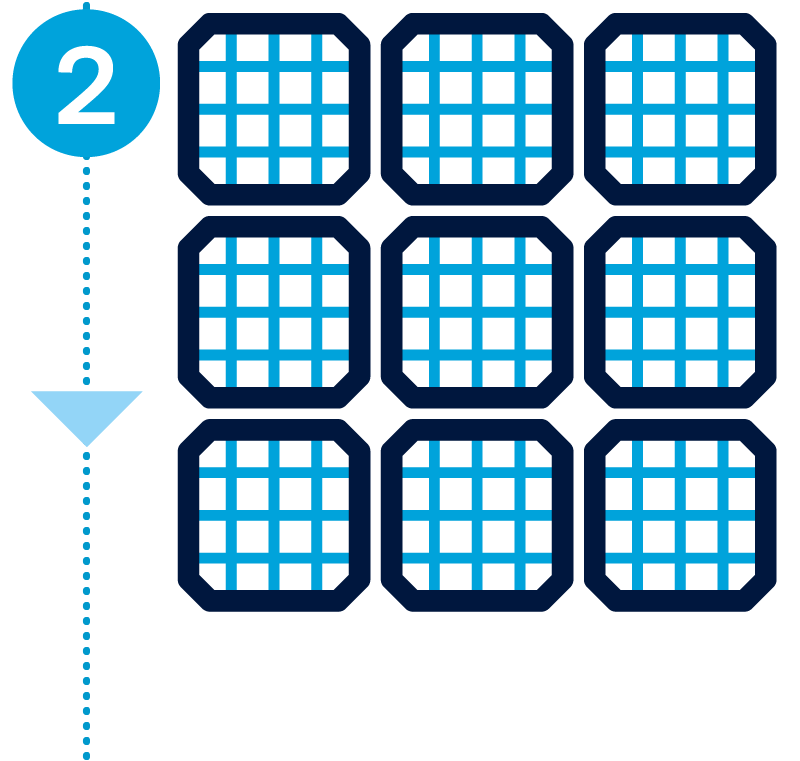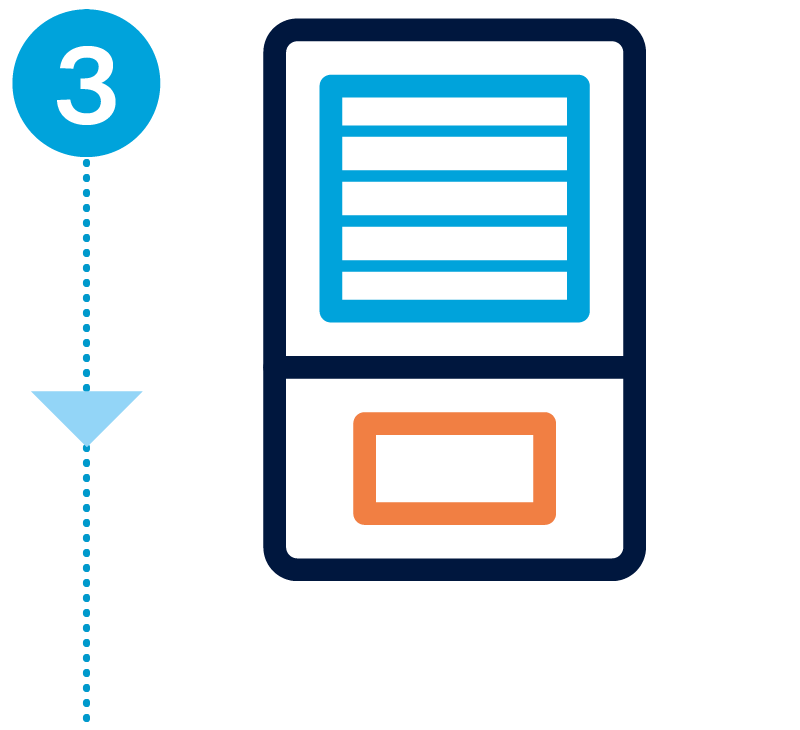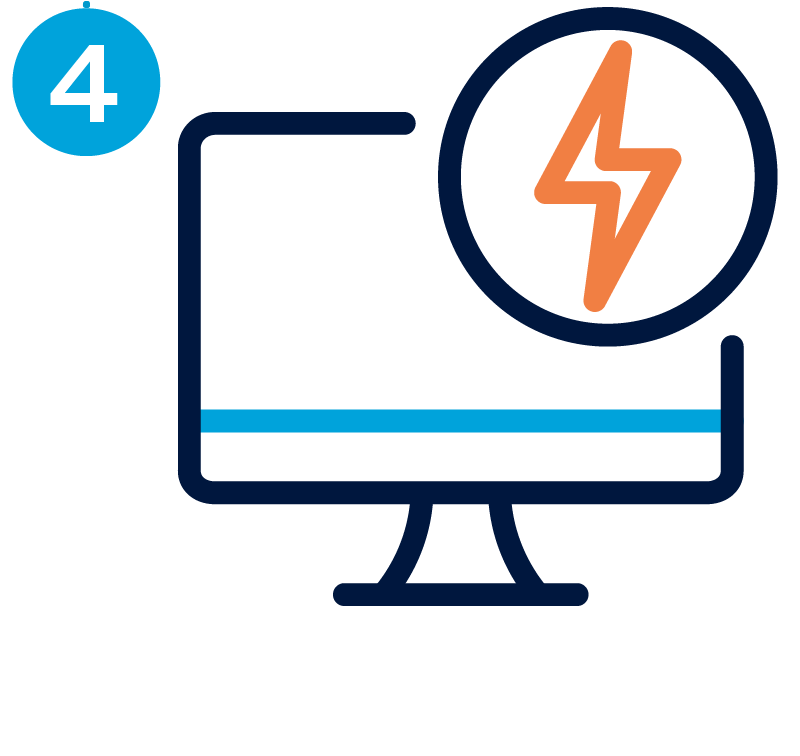The ultimate guide for buying solar in WA
If you’re looking for tips for buying solar panels as part of a solar PV system, this is your ultimate solar panel buying guide. It's a list of things you should know and consider when you’re looking for the best solar PV system for home or business use here in WA.
Blog contents:
- How a solar PV system works
- The benefits of installing solar panels
- What makes up a solar PV system?
- Your guide to solar panels
- Your solar inverter buying guide
- Rooftop solar racking and mounting
- Solar consumption monitoring
- Is buying solar a good option for you?
- What size solar PV system do you need?
- Choosing a solar installer
- The cost of buying solar
- Government rebates and financial incentives for buying solar
- The role of solar in WA's energy future
Let's start with how a solar PV system works
Solar photovoltaic (PV) systems convert energy from the sun, which is a renewable energy source, into electricity that can help power your home or business. If you’re living here in WA, you’re in one of the sunniest parts of the world – so it makes a lot of sense to consider installing solar panels.
Here’s how a solar PV system works:
 |
The sun releases photons of light (a measure of energy). |
 |
These photons hit your rooftop solar panels, which have cells made from a combination of materials including glass (which allows the sunlight through) and silicon. |
 |
The cells in the panels capture the energy when light falls on them, so your rooftop solar panels collect the sunlight while the sun is shining on them, and the panels convert this captured energy into direct current (DC) electricity. |
 |
This DC electricity is fed into your solar inverter, which is part of your solar PV system. The inverter converts the DC electricity into alternating current (AC) power, which can then be used to power your home and appliances. |
Fun fact:
Every hour, the sunlight received by Earth could theoretically generate enough solar energy to meet the world's global power needs for a whole year.
The potential benefits of installing solar panels
If you’re considering buying solar panels, you might be keen to learn about the potential benefits of solar power. These include:
- Solar energy comes from the sun so it’s a renewable energy source which can help reduce reliance on fossil fuels or other non-renewable energy sources.
- Investing in a solar PV system can mean you need to buy less electricity from the energy system, which could help to reduce your electricity costs.
- It's possible to receive a credit for any excess electricity that you feed into the energy system, if you are eligible, which is known as a feed-in tariff. We’ll explain these in more detail later.
- Installing solar panels could potentially add value to your home, attracting buyers due to the potential to provide savings on electricity costs and appealing to those buyers looking for ways to reduce their impact on the environment.
Solar buying guide: What are the potential benefits of solar panels? Some advantages and disadvantages of installing a solar PV system
If you’re running a business, commercial solar PV system solutions can have other potential benefits. Installing renewable energy generation infrastructure could help demonstrate your commitment to reducing your reliance on non-renewable energy sources to your customers and the wider community. Having a solar PV system for your business could help to give you an edge over your competitors as you show your company is taking active steps towards building a more sustainable future.
Solar buying guide: 5 things to know about investing in solar panels for home or business
What makes up a solar PV system?
There are four main parts of a solar PV system:
- Solar panels
- Solar inverter
- Racking/mounting
- Monitoring
We’ll look at these elements in more detail as part of this solar buying guide below.
It’s important to know that even with a rooftop solar PV system, most houses in Australia will still need to be connected to the energy system. This means your home can draw electricity from the energy system at night, when the sun is not shining and when your solar PV system isn't generating electricity, or if you need more energy than your solar PV system is generating. If your house is connected to the grid, you may also be able to feed any excess electricity generated to the energy system.
If you want to store any solar power your solar PV system generates during the day that you don’t use within your home or business, you might also choose to invest in a solar battery as part of your solar PV system.
Solar buying guide: How does a solar battery work?
Your guide to solar panels
Rooftop solar panels are designed to convert solar energy from sunlight into DC electricity. Depending on the manufacturer, your solar panels could include different cell types and arrangements such as polycrystalline, monocrystalline, half-cut and shingled.
The Australian solar industry is competitive, so you’ll find a range of different brands available at different price points. Different brands and types of solar panels might often look similar but will generally have different power levels, quality and technology – so make sure you know exactly what you’re paying for.
Because Western Australia experiences extreme weather conditions, consider the quality of the solar panels and whether they are suitable for WA conditions before purchasing a solar PV system.
Generally little maintenance and minimal cleaning is required, so it can be simple to look after your panels and keep them in optimal condition.
Solar buying guide: Your no-sweat guide to cleaning your solar panels
Your solar inverter buying guide
Your solar inverter is essentially the engine room of your solar PV system. It works hard to convert DC electricity into AC electricity, which is the energy you use in your home or business.
String inverters are a common type of inverter that forms part of a solar PV system. String inverters connect all the solar panels in a solar PV system to it. String inverters are similar to Christmas lights in that if one light doesn’t work, the whole display could be out of action. In the case of a solar PV system with a string inverter, if one part of your solar panels is shaded, or even damaged, then the overall production of your whole system will be impacted.
Microinverters are another type of inverter that can form part of a solar PV system. These Microinverters are built into each solar panel, which means that unlike a string inverter, if one panel is shaded or damaged, it shouldn't affect the output of the rest of the solar PV system. This type of solar inverter can work well for some rooftop solar panel placements that may experience shadowing from nearby trees or neighbouring properties, or where the solar panels face different directions. It is worth noting that microinverters are generally more expensive than the string inverters, so it is important to factor this in to your decision.
Your solar installer should make sure your inverter is installed as close as possible to your electricity meter. Unlike installing solar panels to collect full sun, it’s generally recommended to have the inverter installed in a cool location away from direct sunlight where possible, such as a garage. An accredited solar installer should be able to advise the best place to install your inverter at your property.
It may be worth investing in a good quality inverter since this is a part of a solar PV system that most likely to fail 10 to 15 years after installing a solar PV system.
Solar buying guide: How does a solar inverter work
Racking and mounting your rooftop solar panels
The racking or mounting is the part which connects your solar panels to your roof. Your solar supplier should work with you to work out how to fit your solar PV system on your roof for best results. They should examine your roof space and consider any shading issues or trees and buildings which could have an impact on the performance of your solar PV system.
Generally in WA, the ideal angle for solar panels is 28 degrees to catch the most sunlight. Depending on your roof design and the solar PV system you choose, your solar panels might be mounted on tilt frames to achieve the best angle.
The ideal position for your solar panels depends on a range of factors but generally north-facing panels will receive the most sunlight here in WA. Having said that, east or west-facing panels could be a better option based on your roof space, how you use electricity and other factors. For example, west-facing panels may be a good option if your household uses a lot of electricity in the afternoon compared to other times of day.
You could also try to shift your electricity usage habits, for example with timers on your appliances, to make the most of electricity your solar PV system generates.
Solar buying guide: A day in the life of a solar super user
Consumption monitoring as part of your solar PV system
You could consider having a consumption monitor installed to measure how much electricity is moving to and from the energy system. Consumption monitors are small devices that sit in your switchboard and are generally offered as an optional extra when installing a solar PV system. Your solar inverter will tell you how much solar energy your solar PV system produces and some can also provide additional usage information – but a consumption monitor can offer greater detail, enabling you to see how much solar power is being produced and when your home is using this electricity. The more you know about how and when your home uses electricity, the easier it can be to make the most of your investment in solar.
Solar buying guide: How to use your solar data to change your energy habits
Is buying solar a good option for you?
Buying solar panels can have many potential benefits – but it’s not always the right solution for every home or business, for example if you’re renting and likely to change address before you see the benefits of your purchase.
You will need to take your electricity needs and behaviours into consideration when deciding to install a solar PV system. The main things to consider are how much electricity you use – and when. If you use most of your electricity in the morning or at night, you may struggle to use the solar power generated by your rooftop solar PV system.
Depending on your situation, you might need to change your usage habits or consider installing a battery to take advantage of your solar power generation.
Solar buying guide: A new solar owners guide
For businesses, buying solar panels could be worthwhile if you can use the electricity they generate – but there are other ways your business could benefit from installing renewable energy generation.
Solar buying guide: Green energy for business: Simple ways to take action today
What size solar PV system do you need?
The size of system that you need will depend on a number of factors including your budget, your roof layout and – most importantly – how and when you use electricity. You should also consider whether your electricity requirements are going to increase in the future, for example if you’re considering an electric vehicle, if you’re close to retirement and will be at home more, if you’re welcoming a new family member or planning a pool or new air conditioning.
If you are considering a commercial solar solution, think ahead about how your business operations will expand and how this might impact your electricity use.
Fun fact:
In 2020, small-scale solar PV systems (systems up to 100 kW) generated almost one quarter of Australia's renewably-sourced energy generation and produced 6.5% of Australia’s total electricity.
Solar buying guide: “What size solar system do I need?” Here’s how to work it out
Choosing a solar installer
The size of the solar industry in Australia means you have plenty of options to consider when you’re buying solar panels.
Consider choosing a solar retailer which has been accredited as a New Energy Tech Consumer Code (NETCC) Approved Seller, formerly the Clean Energy Council (CEC) Approved Solar Retailer program and always make sure the person installing your solar PV system is accredited by the CEC.
Look for a reputable solar retailer with plenty of experience in the WA market. It’s worth shopping around for multiple quotes so you can compare the quality, price, warranties and other factors – and read company and product reviews online before making your decision. Beware of high-pressure sales tactics and any deals which seem too good to be true.
Solar buying guide: Red flag alert: What to watch out for when you’re buying solar
The cost of buying solar
There’s no such thing as a ‘one size fits all’ solution when you’re buying solar panels. Your solar retailer should ask for a copy of your last few electricity bills to examine how much electricity you use and match you with an appropriate solar PV system based on your needs. If you are a Synergy customer and have a smart meter at your property, you can use My Account to look at your energy interval data for details on how you use electricity at different times of day.
Quality solar PV systems are an investment in your home or business and one that you want to last. It’s worth looking for high-quality solar PV system components rather than just searching for the cheapest options.
Solar retailers often offer financing through different third-party lenders, so if you are considering a financed option make sure you research the lender and understand all the terms and conditions of the loan contract to avoid any hidden surprises.
Solar buying guide: Tips to help choose a solar supplier
Government rebates and financial incentives for buying solar
A feed-in tariff is a rebate or credit offered to eligible households or businesses with a solar PV system for electricity generated by their system that is exported or fed back into the energy system.
In WA, eligible solar PV systems that are 5kW or smaller in size can receive a feed-it tariff through the Distributed Energy Buyback Scheme (DEBS). DEBS buyback rates are reviewed each year by the State Government in the same way as other regulated electricity prices.
For residential and small businesses a a financial incentive is available through the Federal Government’s Small-scale Renewable Energy Scheme and based on Small-scale Technology Certificates (STCs), which can be purchased, sold and traded on an open market and have a value that varies with market conditions. STCs are created following the installation of an eligible solar PV system, and are calculated based on the amount of electricity a system can produce. Solar retailers often offer customers, an "up-front discount" when they buy a solar PV power system for the surrender of the STCs created the solar PV system to the solar retailer. This is often referred to as a “solar rebate”.
A solar PV system which can generate more than 100kW is subject to the Large-scale Renewable Energy Target, with a financial incentive available in the form of Large-Scale Generation Certificates (LGCs). One LGC is created for every megawatt-hour of electricity the solar PV system generates. LGCs can be purchased, sold, and traded on an open market as STCs are, so their value can fluctuate in line with supply and demand to meet the Large-scale Renewable Energy Target.
The main difference between STCs and LGCs is that LGCs are produced on an ongoing basis compared to STCs which are created upfront. This means that your business could receive a an ongoing solar “rebate” instead of an "upfront discount" on the cost of a solar PV systems under 100kW in size.
Solar buying guide: The difference between STCs and LGCs
The role of solar in WA’s energy future
The supply and demand of electricity needs to be balanced to keep the South West Interconnected System (SWIS) stable.
On mild, sunny days, the energy output from rooftop solar PV systems is generally high. If the demand for electricity from the energy system on these days is too low, the system can be at increased risk of supply interruptions and blackouts. As many WA home and businesses have now installed rooftop solar PV systems, the issue of ‘low load’ needs to be managed to reduce the risk of blackouts.
To help manage 'low load', maintain the stability of the electricity system and support the continued installation of rooftop solar, the WA State Government introduced emergency solar management (ESM) – the capability to remotely turn off (and on again) solar PV systems that were installed or upgraded from February 2022.
All new and upgraded solar PV systems with an inverter capacity of 5kW or less, and participating in the Distributed Energy Buyback Scheme (DEBS), must now have the capability to be remotely managed under ESM requirements.
New solar PV systems with an inverter capacity over 5kW, will be subject to an export limit. An export limit refers to the maximum amount of solar power generated by a rooftop solar PV system, in excess to personal usage, that is permitted to be exported to, or fed into the energy system.
You can learn more about ESM or check out our ESM FAQ here.
Share: